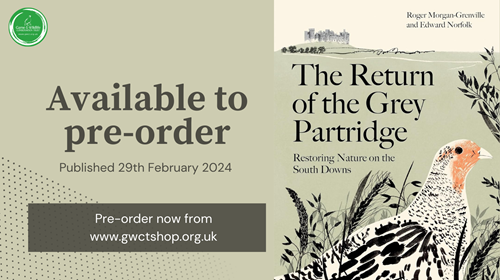Written by Roger Draycott, Director of Advisory Services & Education

Return of the Grey Partridge is available from www.gwctshop.org.uk for £20
In recent years there has been a plethora of books about nature conservation in Britain and the biodiversity crisis in which we find ourselves. Some of these books offer suggestions on how to recover nature, often with the focus on re-wilding or re-purposing of land.
This book though is one of only a small, select group of books that demonstrates unequivocally that nature can be restored to impressive levels within a working and productive agricultural landscape. In other words, it describes very eloquently how farming and nature conservation can go hand in hand.
It tells the story of how the Duke of Norfolk (Eddie to his friends and fellow partridge enthusiasts) and his team turned around the fortunes of the grey partridge – at the time on the brink of local extinction - and in doing so reversed the long-term decline of the whole arable ecosystem bringing life and colour back to the fields of the South Downs.
The book, wonderfully written by Roger Morgan-Grenville, begins in 2002 when partridge guru Dr Dick Potts, then recently retired as Director General of the GWCT, went to see the Duke in his estate office during the GWCT’s annual partridge count on the Sussex Downs to highlight the perilous state the partridges were in.
Without immediate intervention, Dick explained, grey partridges would be lost from the local farms. The book details how the Duke, the farm management team, the gamekeeping team and a wide range of ecologists and advisors all worked together, with a little help from like-minded landowners and gamekeepers, to restore grey partridges to a level that a sustainable harvest of wild grey partridges could be achieved.
The book does not shy away from the fact that a key driver for the project was the ultimate goal of being able to shoot some wild grey partridges with friends. The sections on the organisation and running of the shoot days, with all the work and people involved will likely be an eye opener for any reader not familiar with the nature of wild gamebird shooting in Britain and I would be surprised if anyone, after reading the book, would not be impressed with the hard work, dedication, nerve, expertise and enthusiasm that is required to run a successful wild grey partridge shoot day.
Although the focus for the project was grey partridges, the measuring of the response of other wildlife has always been important – and it has responded dramatically. It particular, red listed farmland birds - birds which are in serious national decline- like skylark, corn bunting, lapwing, linnet and yellowhammer are now bucking the national trend.
A whole host of important arable wildflower species, dormant in the seed bank for many years are once again flourishing as are many invertebrate species and nine species of raptor currently breed at Peppering Farm, the core project area. This highlights very neatly that the grey partridge is an ‘umbrella’ species for farmland wildlife and that if we look after the grey partridge, wider farmland biodiversity will recover too.
So, what did the team do to recover grey partridges? As the Duke highlights in the foreword, it is not ‘rocket science’. It is about providing the right habitat in the right place at the right time of year, all year. It’s also about providing suitable food for young and adults and protecting the nesting birds, eggs and chicks from predation whilst they are vulnerable in the breeding season.
The is the ‘three-legged stool’ approach, (remove one of the legs and the system fails) long advocated by the Game & Wildlife Conservation Trust. It is the three-legged stool on which we urge Defra to base its nature recovery strategies for restoring farmland wildlife within future agri-environment schemes.
This book should be essential reading for anyone interested in farming and nature conservation, it will likely become a classic. The one omission in the book is that is does not discuss how influential the Duke and his team have been in inspiring a whole host of other partridge recovery projects across Britain.
Some of these are small family farms and others are much grander akin to the Duke’s own project in Sussex. What we need is lots more of these projects – to bring about a national recovery in farmland biodiversity. This requires support from government and in the words of the Duke ‘my plea to government is for a more constructive and efficient relationship with the private sector to work with us and allow us to flourish in nature’s revival by working together’.
Order Book >